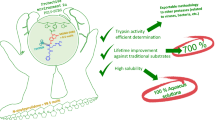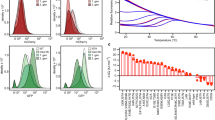Abstract
THE specificity of pepsin has been extensively investigated, and the information obtained from work using synthetic di- or tri-peptides indicates that pepsin preferentially hydrolyses peptides which contain a tyrosine or phenylalanine residue1,2. However, Sanger, using the A and B chains of insulin, found that peptide linkages which did not involve tyrosine or phenylalanine were hydrolysed by pepsin3,4. Bovey and Yanari5 recently reviewed the action of pepsin on synthetic peptides and proposed several general rules. It was pointed out, however, that these rules “do not necessarily apply to the peptic digestion of proteins and large polypeptides, which is often considerably more extensive than these rules would lead one to expect”. In order to understand the action of pepsin on protein substrates, we have made a systematic examination of the sequence of amino-acid residues adjacent to the site of peptic hydrolysis in several proteins of known amino-acid sequences. In this communication, a concept is proposed which explains the specificity of pepsin for protein substrates in terms of a hypothetical ‘hydrophobic binding site’.
This is a preview of subscription content, access via your institution
Access options
Subscribe to this journal
Receive 51 print issues and online access
$199.00 per year
only $3.90 per issue
Buy this article
- Purchase on Springer Link
- Instant access to full article PDF
Prices may be subject to local taxes which are calculated during checkout
Similar content being viewed by others
References
Fruton, J. S., Bergmann, M., and Anslow, jun., W. P., J. Biol. Chem., 127, 627 (1939).
Baker, L. E., J. Biol. Chem., 193, 809 (1951).
Sanger, F., and Tuppy, H., Biochem. J., 49, 481 (1951).
Sanger, F., and Thompson, E. O. P., Biochem. J., 53, 366 (1953).
Bovey, F. A., and Yanari, S. S., in The Enzymes, edit. by Boyer, P. D., Lardy, H., and Myrback, K., 5, 63 (Academic Press, New York, 1960).
Li, C. H., Symposium on Protein Structure, edit. by Neuberger, A., 302 (John Wiley, Inc., New York, 1958).
Hirs, C. H. W., Moore, S., and Stein, W. H., J. Biol. Chem., 235, 633 (1960).
Konigsberg, W., and Hill, R. J., J. Biol. Chem., 237, 3157 (1962).
Némethy, G., and Scheraga, H., J. Phys. Chem., 66, 1773 (1962).
Cohn, E. J., and Edsall, J. T., Protein, Amino Acids and Peptides (Reinhold Pub. Corp., New York, 1943).
Author information
Authors and Affiliations
Rights and permissions
About this article
Cite this article
TANG, J. Specificity of Pepsin and its Dependence on a Possible ‘Hydrophobic Binding Site’. Nature 199, 1094–1095 (1963). https://doi.org/10.1038/1991094a0
Issue Date:
DOI: https://doi.org/10.1038/1991094a0
This article is cited by
-
Comparative effects of high pressure processing and heat treatment on in vitro digestibility of pea protein and starch
npj Science of Food (2022)
-
Time-dependent nature in peptic hydrolysis of native bovine hemoglobin
European Food Research and Technology (2007)
-
Zur Isolierung und Identifizierung von Peptiden aus dem peptischen Hydrolysat des Weizengliadins Ein Beitrag zur Aufkl�rung der Prim�rstruktur des Weizengliadins
Zeitschrift f�r Lebensmittel-Untersuchung und -Forschung (1968)
-
Zur Isolierung und Identifizierung von Peptiden aus dem peptischen Hydrolysat des Weizengliadins Ein Beitrag zur Aufkl�rung der Prim�rstruktur des Weizengliadins I. Mitteilung Chromatographische und elektrophoretische Auftrennung des peptischen Hydrolysates
Zeitschrift f�r Lebensmittel-Untersuchung und -Forschung (1968)
-
A characteristic fragment of the polypeptide chain of pepsin
Chemistry of Natural Compounds (1967)
Comments
By submitting a comment you agree to abide by our Terms and Community Guidelines. If you find something abusive or that does not comply with our terms or guidelines please flag it as inappropriate.



